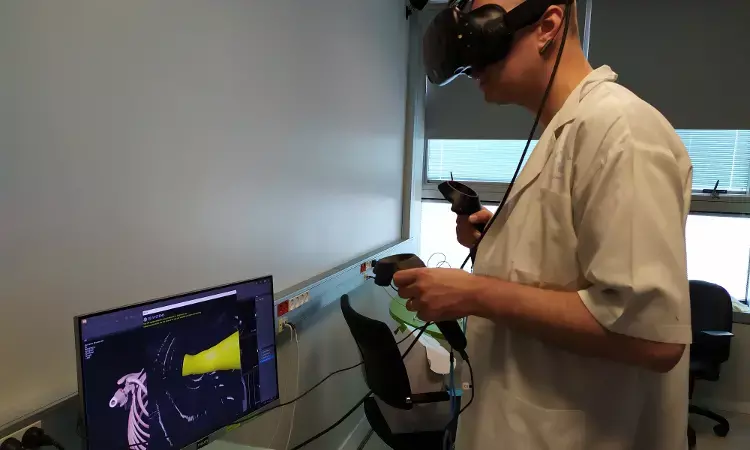- Home
- Medical news & Guidelines
- Anesthesiology
- Cardiology and CTVS
- Critical Care
- Dentistry
- Dermatology
- Diabetes and Endocrinology
- ENT
- Gastroenterology
- Medicine
- Nephrology
- Neurology
- Obstretics-Gynaecology
- Oncology
- Ophthalmology
- Orthopaedics
- Pediatrics-Neonatology
- Psychiatry
- Pulmonology
- Radiology
- Surgery
- Urology
- Laboratory Medicine
- Diet
- Nursing
- Paramedical
- Physiotherapy
- Health news
- Fact Check
- Bone Health Fact Check
- Brain Health Fact Check
- Cancer Related Fact Check
- Child Care Fact Check
- Dental and oral health fact check
- Diabetes and metabolic health fact check
- Diet and Nutrition Fact Check
- Eye and ENT Care Fact Check
- Fitness fact check
- Gut health fact check
- Heart health fact check
- Kidney health fact check
- Medical education fact check
- Men's health fact check
- Respiratory fact check
- Skin and hair care fact check
- Vaccine and Immunization fact check
- Women's health fact check
- AYUSH
- State News
- Andaman and Nicobar Islands
- Andhra Pradesh
- Arunachal Pradesh
- Assam
- Bihar
- Chandigarh
- Chattisgarh
- Dadra and Nagar Haveli
- Daman and Diu
- Delhi
- Goa
- Gujarat
- Haryana
- Himachal Pradesh
- Jammu & Kashmir
- Jharkhand
- Karnataka
- Kerala
- Ladakh
- Lakshadweep
- Madhya Pradesh
- Maharashtra
- Manipur
- Meghalaya
- Mizoram
- Nagaland
- Odisha
- Puducherry
- Punjab
- Rajasthan
- Sikkim
- Tamil Nadu
- Telangana
- Tripura
- Uttar Pradesh
- Uttrakhand
- West Bengal
- Medical Education
- Industry
Anesthesiologists use 3D printing to prepare for lung surgery on young girl
 Courtesy European Journal of Anaesthesiology
Courtesy European Journal of AnaesthesiologyAn anaesthesia team in Israel has become one of the first to use 3D printing and virtual reality to produce an exact model of the airway of a 7-year-old girl in order to prepare properly for an operation to remove part of her lung. This pioneering report is published in this month's edition of the European Journal of Anaesthesiology (the journal of the European Society of Anaesthesiology [ESA]).
The young girl required part of her right lung to be removed due a case of Ewing's Sarcoma (a bone and soft tissue cancer) spreading to her lung. However, because of her small size (just 18kg at the time of the operation), her doctors had concerns that conventional tubing and devices used for lung operations in older patients may not be appropriate and thus decided to use CT scans to create a virtual reality program of her airway/wind pipe and lungs, and also an exact 3D printed plastic model so they could practice the operation beforehand.
"Despite extensive adult experience, our familiarity with one lung ventilation(OLV) in the very young paediatric population is limited," says Dr Ruth Shaylor of the Division of Anesthesia, Pain and Intensive Care, Tel Aviv Sourasky Medical Center, Tel Aviv, Israel, the lead author on the report. "We used a combination of 3D printing and virtual reality bronchoscopy to develop a personalised airway plan reducing the potential for trial and error in airway manipulation during the operation."
The day before surgery, the treating anaesthesiologist spent time on the virtual reality simulator familiarising himself with the patient's airway anatomy. Thereafter, the model was used to formulate an individualised airway plan. The 3D model was made of hard plastic, because the team felt that anything more flexible might mean something larger than the patient could tolerate might be used.
The VR and 3D model meant that some of the equipment originally planned for the operation was changed. After the girl was placed under anaesthesia, they were able to safely isolate and ventilate her left lung and perform the surgery to remove part of her right lung. "During the procedure, the treating anaesthesiologist reported a good correlation between the patient's anatomy and the VR model, allowing the operation to proceed as planned," says Dr Shaylor. "At the end of the procedure, the tubing and equipment was removed easily and the patient made an uneventful recovery."
"To date, the use of 3D printing in anesthesia has been mainly for educational purposes, she concludes. "3D printing in anesthesia is underutilized for patient-specific pre-operative planning. The same applies to the use of virtual reality in anesthesia. We successfully combined both technologies to produce a personalized airway plan for a child patient. The final airway plan was substantially different to the plan developed using standard imaging techniques. This reduced the number of attempts at lung isolation that would have otherwise been performed on the patient."
for further references log on to:
For full case report, see: https://drive.google.com/file/d/1VHaVIbjSIF-KUj0eo1iM1GNA55mbShnl/view
Dr Kamal Kant Kohli-MBBS, DTCD- a chest specialist with more than 30 years of practice and a flair for writing clinical articles, Dr Kamal Kant Kohli joined Medical Dialogues as a Chief Editor of Medical News. Besides writing articles, as an editor, he proofreads and verifies all the medical content published on Medical Dialogues including those coming from journals, studies,medical conferences,guidelines etc. Email: drkohli@medicaldialogues.in. Contact no. 011-43720751


